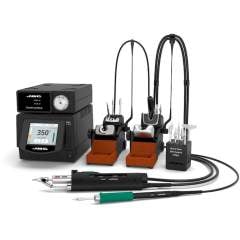JBC's Contribution to Advanced Soldering Applications
JBC's Contribution to Advanced Soldering Applications
Blog Article
Unmatched Precision with JBC Soldering Tools
Automation and action get a grip on programs are spinning the rules of production, logistics, and also energy management. Behind the curtain, amazing products and services and effective innovations are operating performance, sustainability, and output to remarkable new heights. What makes these alternatives such a hot soldering station (lötstation) topic, and why are they frosting trend lists in industrial circles?

Surrounding the Potential with Numbers and Styles
Nowadays, around 60 per cent of factories in sophisticated economies have applied some amount of computerized movement control. Contemporary sensors, electrical pushes, and electronic controllers now underpin from robotics to conveyor belts. According to a 2023 record, the world wide activity control industry alone is predicted to attain $21 million by 2027. That number presents a compounded annual development rate (CAGR) of 6.5 %, showing exactly how keen industries are to follow high-precision automation.
But it's not only standard factories that are benefitting. Circulation stores across North America and Europe are reimagining workflows through sensible conveyor methods and autonomous vehicles. These improvements improve throughput by around 30 percent, cut work costs, and lower error costs across fast-paced present chains.
Accuracy Meets Production
High-precision action engineering has become a must-have in areas demanding accuracy and reliability. Semiconductor production is one of these, wherever linear movement guides and multi-axis controllers offer precision measured in microns. New surveys reveal that companies leveraging these answers see trouble charges decrease by as much as 40 %, giving them a significant edge in a fiercely aggressive field.
Alternative power and e-mobility are viewing related revolutions. Wind and solar installations increasingly depend on real-time automation to boost energy catch and improve maintenance. That smart approach helps cut downtime, with one study noting a 20 percent lowering of preservation prices at features which have followed computerized get a grip on systems.
The Wise Factory Innovation
Automation is no longer nearly lowering human error. It's about making intelligent factories, where every part communicates seamlessly. Technologies offering predictive analytics and IoT connection check machinery health and predict maintenance needs before breakdowns occur. Research shows that predictive preservation can decrease unplanned downtime by up to 50 per cent, translating into substantial savings for seed operators.
From automotive companies ramping up generation pace to logistics firms seeking accurate handling and energy savings, the numbers tell a powerful story about this accelerating sector. If you monitor current tendencies or shape purchasing conclusions, understanding wherever the industry is headed is crucial.
What's Next for Automation and Motion Control?

The concentrate on sustainability, data-driven manufacturing, and smarter offer organizations will only grow. International need for robotics and clever controllers continues to go up, specially in areas wherever performance and adaptability mean survival. Industries investing in next-generation automation are placing themselves apart—with the figures to prove it.
For organizations mapping out their next shift, automation and action control are becoming less of an option and more of a necessity. With returns calculated in larger production, lower expenses, and new capabilities, the case for ownership hasn't been clearer.
Report this page